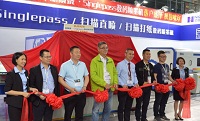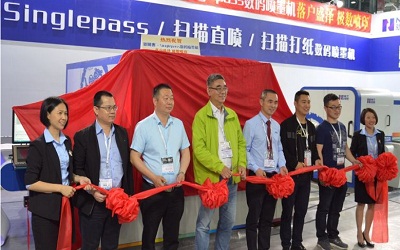FW
The 10th International Pakistan Textile Machinery and Garment Technology (IGATEX) 2017 exhibition opened its doors at the Karachi Expo Centre today. Exhibitors and organisers are optimistic about achieving their targets as more than 550 international and local manufacturers of textile machinery and technology from 35 countries are showcasing their latest products at the four-day exhibition.
There are 73 companies from Italy, 70 from Germany, 50 from China, 25 from Turkey and 80 from the host country Pakistan displaying their latest products. The highlight of this exhibition is some 20 companies from India are also participating through their representatives.
Pakistan is in a dire need of modern technology which is lacking in the frontline business. The country is lacking in modern technology which is causing an imbalance in garment industry, the recent example is Bangladesh although a cotton deficit country did trade worth $35billion in the last year.
The maiden IGATEX in 2002, had around 200 companies despite the threat of terror attacks and lack of law and order at that time and the number has increased to 550 in 2017.

Foshan New King Time Machinery (New King Time), also known for its NKT brand of machines, sold its first ‘Single Pass’ textile digital machine at the just concluded edition of TPF 2017. This latest machine was bought by Suzhou Super Digital Printing Technology. The event witnessed both by domestic and foreign media and visitors at TPF, created a lot of enthusiasm and excitement about the Single pass machine.

Single pass is the latest textile digital machine, known for its speed. The machine is being seen as the next level digital technology and can be termed as a bridge technology between existing digital machines and conventional rotary machines. It is available in various widths. As of now, only a handful number of these machines are installed, perhaps less than 15 across the world. The price range of $1.0-1.6 million, is much less compared to similar Italian machines.
NKT also displayed their scanning machines which can print both on paper and fabric, with disperse; reactive ink etc, this will be put into production soone. The company is looking to set up service points in China and abroad. In 2017, NKT plans to make inroads in the textile industry with a variety of digital printing machines.
As per latest figures from the Pakistan Bureau of Statistics (PBS), there has been 6.2 per cent rise year on year in textile and clothing exports which touched $1.064 billion in March this year, mainly driven by value-added products such as garments. Exports of readymade garments registered an increase of 19.5 per cent and knitwear rose to 5.4 per cent. Exports of bed-wear and towels increased 5.4 per cent and 15.8 per cent respectively.
Cotton yarn exports also saw a rise year-on-year of 5 per cent. A decline in exports of cotton cloth and yarn (other than cotton’s) was recorded at 5.5 per cent and 26.9 per cent.The receipts from silk, art and synthetic textile rose 2.7 per cent and the ones from raw cotton declined 2.9 per cent year on year. Exports of items like tents, canvas and tarpaulin rose by 71.8 per cent and made up articles excluding towels increased 16 per cent in the current nine months of this FY 2016-17.
The government in the preceding year had introduced a policy which provided a 4 per cent rebate on exports of readymade garments subject to a 10 per cent rise over previous year, 1 per cent on fabric and 2 per cent on home textile. The exporters were paid out Rs 2.5 billion in the last financial year by the government due to the introduction of this policy. This has made a steady growth to increase the value of Pakistan’s growth within four months.
Bangladesh has overtaken Pakistan as a leading cotton exporter even overtaking India and Vietnam. Pakistan which was the fourth largest exporter of cotton was overshadowed by Bangladesh in the race. Pakistan lead by is embroiled in its fight against terrorism, labor problems, corruption and growing Chinese monopoly. While Bangladesh faces extremism but it’s not affecting the market base. The European Union has allocated trade packages to Pakistan but the country has not utilised it fully. On the other hand Bangladesh has optimistically utilized trade packages provided by the European Union.
In July-December of the current fiscal year, Pakistan exported textile products worth $1.365 billion while Bangladesh clocked in $8.041bn from exports during the same period. Pakistan’s exports were just 17 per cent of the exports by Bangladesh. Textile exports from Pakistan, which is able to buy cheap cotton produced within the country, have been in declining, although they still constitute about 58 per cent of the country’s total exports. Even the Ministry of Commerce failed to bring any improvement in the situation. Neither incentive nor the commerce minister’s frequent visits to abroad could bring any positive change in this regard. In comparison Bangladesh textile exports was 82per cent of its total exports and 20 per cent of its GDP. Textiles made it the fastest-growing developing country, which achieved GDP growth rate of more than 6.5 per cent. Bangladesh has set a target of $50bn exports for 2021. Its exports are expected to surpass $40bn in 2020.
Foreign Investment is lacking in Pakistan due to terrorism. Pakistan mainly exports readymade garments, knitwear and bed-wear to the EU, which has the highest share in the country’s textile exports. In fact, Nawaz Sharif in January had announced a Rs 180 billion incentive package to boost exports. Easygoing textile exporters like to export cotton, cotton yarn and gray cloth, which are considered semi raw materials. Data shows Pakistan exported cotton worth $2.289bn in July 2016-Feb 2017, which is slightly lower than last year.
"Toronto Women's Fashion Week held recently focused on sustainable fashion paradigms. Peggy Sue Deaven-Smiltnieks's sophomore Peggy Sue Collection brought down the house with her farm-to-high-fashion designs one day after former Project Runway Canada star Evan Biddell showcased his saucy repurposed Value Village collection."

Toronto Women's Fashion Week held recently focused on sustainable fashion paradigms. Peggy Sue Deaven-Smiltnieks's sophomore Peggy Sue Collection brought down the house with her farm-to-high-fashion designs one day after former Project Runway Canada star Evan Biddell showcased his saucy repurposed Value Village collection.
Today, ethical fashion brands are going after a growing demographic of ‘aspirationals’ – a mix of hopeful millennials and Gen-Xers that like to shop but prefer supporting brands with integrity. In the past, a lot of companies just tagged ‘organic’ or ‘green’ on garments because it was trendy. In a post-Paris-climate-change-agreement world, economic drivers for sustainability have changed gears. There's a lot more awareness around how to have a triple bottom line approach (people, planet, profits), says Kelly Drennan, who's worked with over 400 designers and brands as founder of sustainable fashion non-profit Fashion Takes Action. Brands are entrenching sustainability throughout the supply chain. They are building proper sustainability teams instead of just tacking on a sustainable marketing director and greenwashing.

Lately Mango has a new, mostly organic cotton collection in stores this season called Mango Committed. Zara has rolled out more than 150 products for the second season of its Join Life collection, spotlighting, amongst other green fabrics, a cool new closed-loop material called Refibra made of recycled Tencel and cotton scraps. H&M's Conscious collection is bigger than ever, including – just in time for Earth Day – a pleated gown in a fabric called Bionic, a polyester made from recycled plastic shoreline waste. The Swedish clothing giant now says it is 26 per cent of the way toward its target of using exclusively sustainable fabrics by 2030.
In the past too, there have been many instances of organic clothing from Aritzia (with its once-green Community line), Lululemon (the Oqoqo line), Levi's, even La Senza, but all these brands pulled them quite soon. How will the sustainable fashion wave tide through the storms remains to be seen?
Sustainability a growing expanse
A 2016 report by the Clean Clothes Campaign, International Labor Rights Forum, Maquila Solidarity Network and Worker Rights Consortium on the safety action plans for H&M's suppliers in Bangladesh concluded that the majority of H&M's factories are still not safe. Greenpeace, however, considers H&M, Zara and Benetton industry leaders for purging a long list of nasty water- and air-polluting chemicals that poison rivers and lungs in places like China and India. So far, 76 major brands, retailers and suppliers have pledged to clean up their acts as part of Greenpeace's Detox My Fashion campaign.
As of now, 100 brands have joined environmental non-profit Canopy Style's push to stop sourcing fabrics derived from ancient and endangered forest. At this point, more than 70 million trees are logged every year (and dissolved with alarmingly neurotoxic chemicals) to make silky forest fibres like rayon/viscose and modal.
How are Indian designers faring?
Back home, designers are also doing the math to distinguish themselves and let consumers know they are producing more thoughtfully. Instead of grinding out fast fashion in dizzying quantities, they are slowing production schedules, making more durable, seasonless garments and aiming for zero waste, all while trying to pay workers a decent wage.
US cotton exports in 2016-17 are forecast to rise 53 per cent from the previous season. Overall, the US share of world trade is expected to reach 39 per cent, up 26 per cent from the last season, which would be the highest level in six years.
The US share of China’s cotton imports has rebounded remarkably from 11 per cent last year to 35 per cent. For Vietnam, Indonesia, Pakistan, and Bangladesh, US cotton exports for the August-February period are up by more than 140 per cent. This further supports the strong share of the US in the global market.
As for other countries, India’s exports are down to four million bales as high domestic prices have slowed sales. Australia’s exports are down to 3.9 million bales as old crop stocks are exhausted and yet-to-arrive new crops face stronger competition. Uzbekistan’s cotton exports are down to 1.5 million bales on lower demand in some of its major markets as well as policies withholding supplies for domestic use.
Greece’s exports are expected to rise on higher production as well as a strong pace of trade to date. Similarly for Brazil on higher carrying stocks due to reduced use estimates in the back year.
Indonesia’s Sritex group has bolstered its production capacity in spinning mills and finishing. With this expansion, Sritex currently has 24 spinning mills, seven weaving plants, five finishing plants and eleven garmenting units, with a total employee strength of over 50,000 people. Development and improvement of human capital is the company's priority. In the two months of early 2017, Indonesia’s textile and textile product exports were up three per cent compared to the same period in the previous year.
The textile sector in Indonesia is an export-oriented labor-intensive one. It employs around three million workers, which is about 17.03 per cent of the total workforce in the manufacturing industry. The national textile industry during the last three years has been driven by new investments and factory expansion to increase production capacity.
For the national textile industry to improve its competitiveness, not only the capital and technology aspects but also competent human capitals are necessary. Therefore, efforts are being made to facilitate the improvement of human resources through a program of cooperation that links and matches industrial companies with vocational high schools. The program involves as many as 50 companies and 234 vocational high schools in east Java.
Luxury shoe and bag retailer Jimmy Choo, with market value of over 700 million pounds (Rs 5,800 crores), has been put up for sale. The retailer says they have decided to conduct a review of the various strategic options open to the company to maximise value for its shareholders. The move was backed by the company's independent directors and JAB luxury, its majority shareholder with a stake of 68 per cent. JAB, an investment company owned by Germany's billionaire Reimann family, wants to sell its stake in the shoes group to focus on food and other consumer goods.
Shares in Jimmy Choo jumped 10 per cent to a record high of 186.25 pence on the news, valuing the group at more than 720 million pounds. The company floated on the stock market in 2014 at a price of 140 pence a share, valuing it at about 550 million pounds.
The sale is expected to attract interest from strategic American buyers as well as Chinese and Russian bidders. The company was founded in London in 1996 by the Malaysian fashion designer Jimmy Choo and the then Vogue accessories editor Tamara Mellon. It runs 150 stores around the world including India, opening 10 last year as well as refitting 16 shops. Men's shoes remain its fastest-growing category and account for nine per cent of revenue.
Since the EU referendum and is expanding in China Jimmy Choo company has benefited from the drop in Sterling. It has fared better than other luxury retailers such as Burberry, which were hit by Chinese tourists cutting back on luxury purchases.
Amsterdam hosted the Kingpins Show on April 19 and 20, 2017. The show gathered a record number of 90 exhibitors – including accessory manufacturers, garment manufacturers, laundries and full-package providers. The show included more worldwide companies from the value chain.
Trends for the fall/winter 2018/19 were on display. Most influencing will be the return to ’80s and ’90s silhouettes and fabric optics. Oversize jackets and tops, cropped, boxy or boyfriend cut jeans will characterize the evolution of the market. More and more open-end denim with flatter and more regular surfaces will be must haves for seasons to come. Artistic Milliners presented various fabrics including a very open construction, relaxed and slouchy hand denim.
Among some of the most striking innovations launched at Kingpins was US Denim’s new ‘Duvet Denim’. This new authentic looking fabric incorporates leftovers from bird feathers and offers higher insulation from cold, a very soft touch and an interesting nap surface. Part of the new collection is Fluff Wear, a denim fabric that integrates natural and regenerated fibers – remains from the weaving process - blended, spun and woven into new extra soft denim.
Many companies also offered fabrics treated with sulfur dye blues, duck brown and ochre effects.
The volume of Kenyan apparels shipped to the US under the African Growth and Opportunity Act declined by 12.1 per cent last year. The AGOA allows US buyers to import goods from sub-Saharan Africa without paying duties or facing quota restrictions. But whether AGOA will continue to be favored by the US remains uncertain.
The US is Kenya’s largest apparel export destination. Textiles and apparel account for about 80 per cent of Kenya’s total exports to the US under the pact. Direct employment generated by AGOA increased by 2.5 per cent in 2016 while the number of enterprises operating at the export processing zones in Kenya increased to 91 from the 89 recorded in 2015. Total sales by the enterprises in the 65 export processing zones increased by 5.8 per cent in 2016 compared to the year before.
Exports from the export processing zones increased 3.7 per cent, accounting for 91.9 per cent of total sales. With the country becoming more visible on the global map, local traders are increasingly opening more supply channels to the US, helped by increased interactions with American investors. Kenya is looking to expand the list of products it exports.












